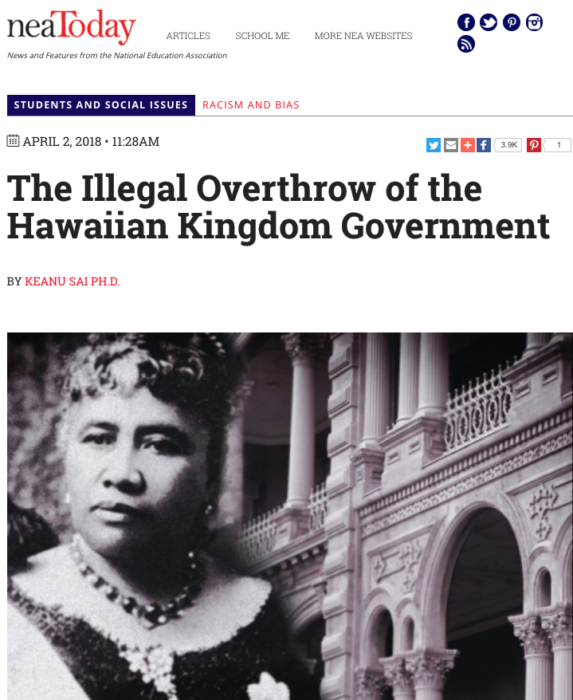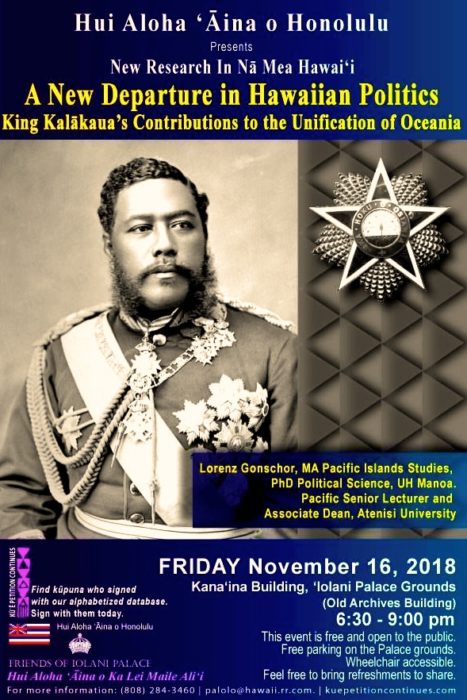
La Ku‘oko‘a (Independence Day) on Hawai‘i Island
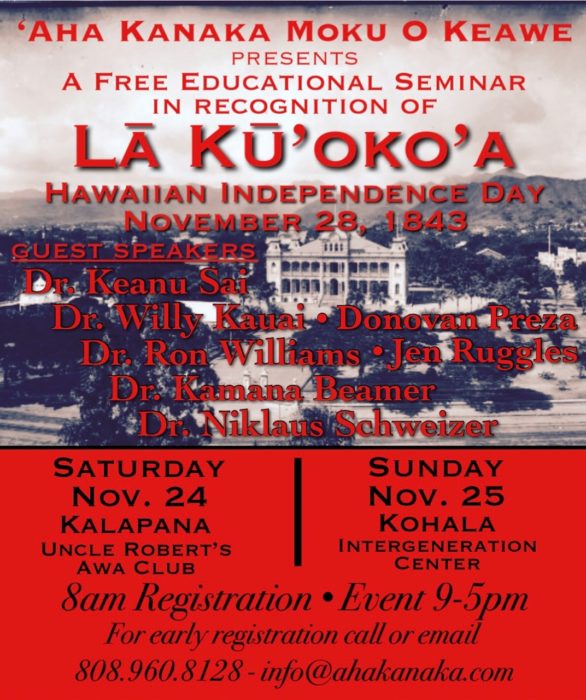
Unfit for a Queen: Eugenics and Hawaiian Education in Territorial Hawai‘i
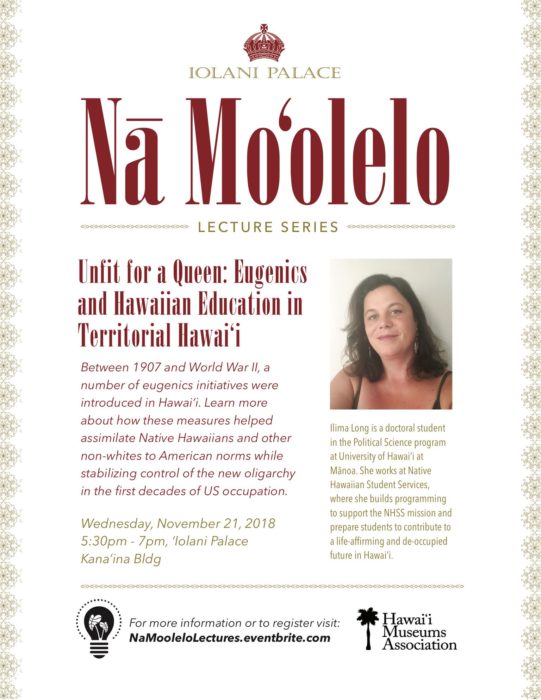
NEA Teachers Union Published Second Article on the American Occupation of Hawai‘i
As part of a three part series the National Education Association (NEA) has published a second article on the American occupation of Hawai‘i. The NEA is the largest labor union in the United States comprised of public school teachers, administrators, and faculty and administrators of universities. This second of three articles is titled “The U.S. Occupation of the Hawaiian Kingdom.”
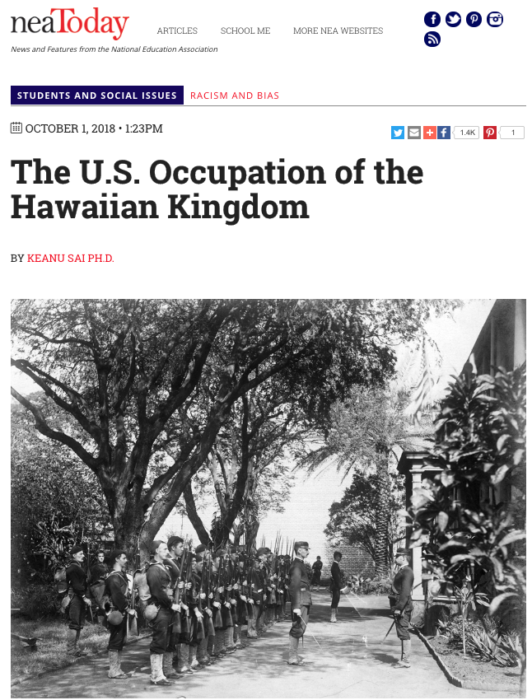 The NEA’s article stems from a resolution that was passed by its delegates who met at their annual convention in 2017 in Boston, Massachusetts.
The NEA’s article stems from a resolution that was passed by its delegates who met at their annual convention in 2017 in Boston, Massachusetts.
The resolution was introduced by the delegates of the Hawai‘i State Teachers Association, which is an affiliate labor union of the NEA, and it passed on July 4, 2017. The resolution was referred to as New Business Item 37, which stated:
“The NEA will publish an article that documents the illegal overthrow of the Hawaiian Monarchy in 1893, the prolonged occupation of the United States in the Hawaiian Kingdom and the harmful effects that this occupation has had on the Hawaiian people and resources of the land.”
#ProtectedPersonsHawaii
#WarCrimesHawaii
Big Island Video News (BIVN): Ruggles To FBI – Investigate Hawaii War Crimes Allegations
#ProtectedPersonsHawaii
#WarCrimesHawaii
State of Hawai‘i Official Reports Queen’s Hospital and Hawai‘i State Judges to FBI
Puna Council Member Ruggles Reports Queen’s Hospital and Hawaii State Judges to the FBI
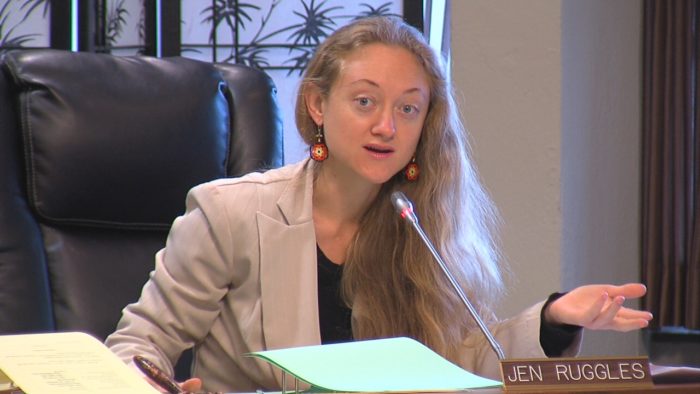
Puna Council Member Jen Ruggles received confirmation that Hawaii’s Federal Bureau of Investigation, (FBI), Special Agent in Charge, Sean Kaul, received her letter reporting Queen’s Hospital and Hawaii Circuit Court Judges for alleged war crimes Monday. Ruggles opened the letter by writing, “To my dismay, I have become aware of Hawai‘i’s status as a nation-state, under international law, which has been under an illegal occupation by the United States since it, by its own admission, illegally overthrew the Hawaiian Kingdom government on January 17, 1893.”
Ruggles made reference to a memorandum released by the United Nation Human Rights Office of the High Commissioner that she says, caused her to look into the issue of potential war crimes more seriously. Ruggles says the memorandum uses the terms “plundering,” “enabling,” and “colluding,” and that she could not take it lightly. In her report to the FBI, she also referred to an article published by the National Education Association in April this year which concluded Hawaii is illegally occupied and that the laws of war apply. The NEA is America’s largest union in the United States with over 3 million members. The Hawaii State Teacher’s association is Hawaii’s chapter.
According to Ruggles, war crimes are felonies and she is legally obligated to report felonies under Title 18 United States Code §4 “Misprision of a Felony” which reads that any person, “having knowledge of the actual commission of a felony cognizable by a court of the United States, conceals and does not as soon as possible make known the same to some judge or other person in civil or military authority under the United States, shall be fined under this title or imprisoned not more than three years, or both.” Ruggles says the FBI’s primary responsibility is to investigate federal crimes. Ruggles also cc’d the International Criminal Court located in the Hague, Netherlands.
Ruggles said, “if the FBI has evidence that the Hawaiian Kingdom does not exist as an independent nation State that has been in an unjust state of war with the U.S. since 1893, and that war crimes and the international crime of genocide as defined under federal law have not taken place, I want to see that evidence. If not, then the FBI is obligated to immediately initiate a criminal investigation.”
Last month Ruggles had sent a letter to Queen’s Hospital explaining how it appears they are committing war crimes against protected persons by abrogating their original charter which mandated free health care to aboriginal Hawaiians. Ruggles also sent a letter to every Hawaii State Circuit Court Judge outlining how foreclosures violate the rights of protected persons in Hawaii, (including Americans), and constitute war crimes.
Ruggles wants to be clear that she is not advocating for those who borrowed money from the lender to disregard their debt owed. As she stated in the letter to the judges, “The lender is protected under the loan title insurance policy that was purchased by the borrower as a condition of the loan. As such, there is no reason to have any foreclosure proceedings in the first place because the defects in titles have rendered all mortgage liens invalid.” According to Ruggles, a defect in title is a covered risk in the loan title insurance policy, and, as such, the lenders should file an insurance claim to have the insurance company pay off the debt owed since the borrower was required to purchase the insurance policy to protect the lender as a condition of the loan.
During Ruggles’ last town hall she announced that she would be “putting every agent of the United States on notice concerning the rights of protected persons.”
#ProtectedPersonsHawaii
#WarCrimesHawaii
Ruggles Puts Hawai‘i State Judges on Notice for Appearing to Commit War Crimes in Foreclosure Proceedings
Informs judges that foreclosure proceedings appear to be in violation of Article 46 of the Hague Convention, IV and Article 47 of the 1949 Geneva Convention, IV
 Council member Ruggles released a letter today that she says she sent to all Hawai‘i Circuit Court judges meant to advocate on behalf of protected persons in foreclosure proceedings.
Council member Ruggles released a letter today that she says she sent to all Hawai‘i Circuit Court judges meant to advocate on behalf of protected persons in foreclosure proceedings.
Ruggles says “Article 46 of the Hague Convention IV provides that ‘Private property cannot be confiscated,” and article 47 of the Geneva Convention IV provides, “Pillage is formally forbidden.”
Ruggles referred to the United Nations Human Rights Independent Expert, Dr. Alfred deZaya’s memorandum that had been sent to Hawaii State Judges in February of this year that stated, “The State of Hawaii courts should not lend themselves to a flagrant violation of the rights of the land title holders and in consequence of pertinent international norms. Therefore, the courts of the State of Hawaii must not enable or collude in the wrongful taking of private lands, bearing in mind that the right to property is recognized not only in U.S. law but also in Article 17 of the Universal Declaration of Human Rights…”
Ruggles wrote that “The ‘wrongful taking of private lands’ by lenders, through the circuit courts of the State of Hawai‘i under foreclosure proceedings, appears to be the war crime of pillaging and that the courts appear to be complicit in a war crime by enabling and colluding ‘in the wrongful taking of private lands.’
Before lenders loan money they require the borrower to mortgage their real estate as collateral to secure the repayment of the loan. In order for the lender to accept the mortgaged property as collateral, the lender requires the borrower to also purchase a loan title insurance policy for the protection of the lender. The title insurance covers the full debt owed under the promissory note.
“As an agent for the United States I am bound ‘to ensure respect for the Convention in all circumstances,’ and, therefore, call upon you to cease and desist ‘in the wrongful taking of private lands’ from protected persons that are under foreclosure,” Ruggles wrote, “the lender is protected under the loan title insurance policy that was purchased by the borrower as a condition of the loan. As such, there is no reason to have any foreclosure proceedings in the first place…”
Ruggles finished the letter by stating, “This letter serves as knowledge and ‘awareness of the factual circumstances that established the existence of an armed conflict’ between the Hawaiian Kingdom and the United States, the application of the HCIV and GCIV, and the protection afforded to protected persons.”
Ruggles sent the letters via certified mail and that she’s verified every judge across the islands received her letter on the Big Island and Oahu on September 25th, Kauai on September 26th, and Maui on September 27th.
Council member Ruggles will be holding a town hall on October 15th at 6pm at the Kea‘au Community Center to discuss this letter, among others that she is working on.
#ProtectedPersonsHawaii
#WarCrimesHawaii
The Three Estates of the Hawaiian Kingdom
There are some today who mistakenly believe that if they can show a family genealogy that traces back to a Hawaiian ali‘i (nobility) they can lay claim to the throne. If this were true than anyone can lay claim. But it is not true because the Hawaiian Kingdom is a constitutional monarchy that provides rules and protocol.
The first rule is that under Hawaiian law titles of nobility are not inheritable. However, in Europe titles of nobility are inheritable, which traces back to the Middle Ages. This is a feudal rule that developed when the nobility were able to inherit their lands and consequently their titles were also inheritable within the family. The Hawaiian Kingdom did not rise from the Middle Ages. It is Polynesian. According to Article 35 of the 1864 Hawaiian Constitution “All Titles of Honor, Orders, and other distinctions, emanate from the King.”
Three Estates of the Hawaiian Kingdom
The government of the Hawaiian Kingdom is a constitutional and limited monarchy comprised of three Estates: the Monarch, Nobles and the People. An Estate is defined as a “political class.” All three political classes work in concert and provides for the legal basis of the government and its authority. Article 45 of the 1864 Hawaiian constitution, provides: “The Legislative power of the Three Estates of this Kingdom is vested in the King, and the Legislative Assembly; which Assembly shall consist of the Nobles appointed by the King, and of the Representatives of the People, sitting together.”
This provision is further elaborated under §768, Hawaiian Civil Code (Compiled Laws, 1884), “The Legislative Department of this Kingdom is composed of the King, the House of Nobles, and the House of Representatives, each of whom has a negative on the other, and in whom is vested full power to make all manner of wholesome laws, as they shall judge for the welfare of the nation, and for the necessary support and defense of good government, provided the same is not repugnant or contrary to the Constitution.” As each Estate has a negative on each other, no law can be passed without all three Estates agreeing.
According to Hawaiian law “No person shall ever sit upon the Throne, who has been convicted of any infamous crime, or who is insane, or an idiot (Article 25, 1864 Constitution),” which, by extension, extends to the Nobles whereby “The King appoints the members of the House of Nobles, who hold their seats during life, unless in case of resignation, subject, however, to punishment for disorderly behavior. The number of members of the House of Nobles shall not exceed thirty (§771, Compiled Laws).”
Representatives of the People shall be Hawaiian subjects or denizens “who shall have arrived at the full age of twenty-five years, who shall know how to read and write; who shall understand accounts, and who shall have resided in the Kingdom for at least one year immediately preceding his election; provided always, that no person who is insane, or an idiot, or who shall at any time have been convicted of theft, bribery, perjury, forgery, embezzlement, polygamy, or other high crime or misdemeanor, shall ever hold seat as Representative of the people (§778, Compiled Laws).”
The number of the Representatives of the people in the Legislature shall be twenty-eight: eight for the Island of Hawai‘i (one for the district of North Kona, one for the district of South Kona, One for the district of Ka‘u, one for the district Puna, two for the district of Hilo, one for the district Hamakua, one for the district of Kohala); seven for the Island of Maui (two for the districts of Lahaina, Olowalu, Ukumehame, and Kaho‘olawe, one for the districts of Kahakuloa and Ka‘anapali, one for the districts of Waihe‘e and Honuaula, one for the districts of Kahikinui and Ko‘olau, one for the districts of Hamakualoa and Kula); two for the Islands of Molokai and Lanai; eight for the Island of O‘ahu (four for the districts of Honolulu that extends from Maunalua to Moanalua, one for the districts of Ewa and Waianae, one for the district of Waialua, one for the district of Ko‘olauloa, and one for the district of Ko‘olaupoko); and three for the island of Kaua‘i (one for the districts of Waimea, Nualolo, Hanapepe and the Island of Ni‘ihau, one for the districts of Puna, Wahiawa and Wailua, and one for the districts of Hanalei, Kapa‘a and ‘Awa‘awapuhi) (§780, Compiled Laws).
Electors of the Representatives shall be Hawaiian subjects or denizens “who shall have paid his taxes, who shall have attained the age of twenty years, and shall have been domiciled in the Kingdom for one year immediately preceding the election, and shall know how to read and write, if born since the year 1840, and shall have caused his name to be entered on the list of voters of his district…shall be entitled to one vote for Representative or Representatives of that district; provided, however, that no insane or idiotic person, or any person who shall have been convicted of any infamous crime within this Kingdom unless he shall have been pardoned by the King, and by the terms, and by the terms of such pardon have been restored to all the rights of a subject, shall be allowed to vote (p. 222, Compiled Laws).”
The Estate of the Crown
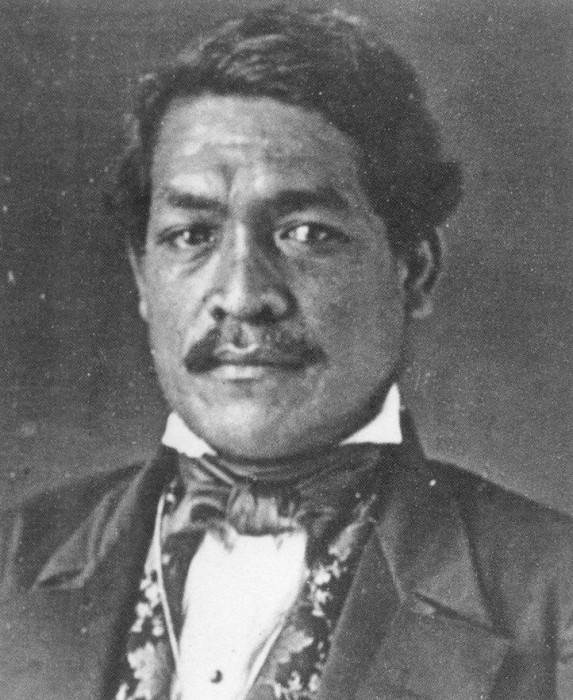 The first constitution of the Hawaiian Kingdom was promulgated in 1840 by King Kamehameha III, which was superseded by the 1852 Constitution. Article 25 of the 1852 Constitution provided: “The crown is hereby permanently confirmed to His Majesty Kamehameha III. during his life, and to his successor. The successor shall be the person whom the King and the House of Nobles shall appoint and publicly
The first constitution of the Hawaiian Kingdom was promulgated in 1840 by King Kamehameha III, which was superseded by the 1852 Constitution. Article 25 of the 1852 Constitution provided: “The crown is hereby permanently confirmed to His Majesty Kamehameha III. during his life, and to his successor. The successor shall be the person whom the King and the House of Nobles shall appoint and publicly 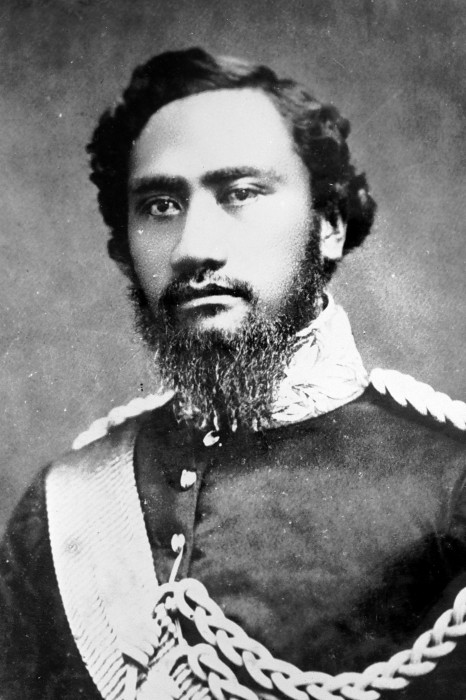 proclaim as such, during the King’s life; but should there be no such appointment and proclamation, then the successor shall be chosen by the House of Nobles and the House of Representatives in joint ballot.” Kamehameha III proclaimed his adopted son, Alexander Liholiho, to be his heir apparent after receiving confirmation from the Nobles in 1853. Alexander ascended to the Throne upon the death of King Kamehameha III on December 15, 1854.
proclaim as such, during the King’s life; but should there be no such appointment and proclamation, then the successor shall be chosen by the House of Nobles and the House of Representatives in joint ballot.” Kamehameha III proclaimed his adopted son, Alexander Liholiho, to be his heir apparent after receiving confirmation from the Nobles in 1853. Alexander ascended to the Throne upon the death of King Kamehameha III on December 15, 1854.
 King Kamehameha V ascended to the Throne through the process of appointment by the Premier (Kuhina Nui) Victoria Kamamalu, and confirmation by the Nobles in 1863, because Kamehameha IV had no surviving children. His son and heir, Prince Albert Kamehameha, died at the age of four
King Kamehameha V ascended to the Throne through the process of appointment by the Premier (Kuhina Nui) Victoria Kamamalu, and confirmation by the Nobles in 1863, because Kamehameha IV had no surviving children. His son and heir, Prince Albert Kamehameha, died at the age of four  on August 27, 1862. Since the young Prince’s death, Kamehameha IV did not appoint a successor before he died on November 30, 1863. According to the 1852 Constitution, Article 47 provided, “Whenever the throne shall become vacant by reason of the King’s death…the Kuhina Nui, for the time being, shall…perform all the duties incumbent on the King, and shall have and exercise all the powers, which by this Constitution are vested in the King.”
on August 27, 1862. Since the young Prince’s death, Kamehameha IV did not appoint a successor before he died on November 30, 1863. According to the 1852 Constitution, Article 47 provided, “Whenever the throne shall become vacant by reason of the King’s death…the Kuhina Nui, for the time being, shall…perform all the duties incumbent on the King, and shall have and exercise all the powers, which by this Constitution are vested in the King.”
In 1864, a new constitution was promulgated by King Kamehameha V, and Article 22 of the 1864 Constitution provides that, “The Crown is hereby permanently confirmed to His Majesty Kamehameha V. and to the Heirs of His body lawfully begotten, and to their lawful Descendants in a direct line; failing whom, the Crown shall descend to Her Royal Highness the Princess Victoria Kamamalu Kaahumanu, and the heirs of her body, lawfully begotten, and their lawful descendants in a direct line. The Succession shall be to the senior male child, and to the heirs of his body; failing a male child, the succession shall be to the senior female child, and to the heirs of her body.” Princess Kamamalu died on May 29, 1866 without any lineal descendants, leaving the successors to the Throne solely with King Kamehameha V.
Since Kamehameha V had no children, Article 22 of the 1864 Constitution provides that a “successor shall be the person whom the Sovereign shall appoint with the consent of the Nobles, and publicly proclaim as such during the King’s life; but should there be no such appointment and proclamation, and the Throne should become vacant, then the Cabinet Council, immediately after the occurring of such vacancy, shall cause a meeting of the Legislative Assembly, who shall elect by ballot some native Ali‘i of the Kingdom as Successor to the Throne.” The Cabinet Council replaced the function of the Premier (Kuhina Nui) under the former constitution, whose office was repealed by the 1864 Constitution, and according to Article 33 would serve as a Council of Regency.
On December 11, 1872, Kamehameha V died without children and he did not appoint a successor. Kamehameha V’s Cabinet, as a Council of Regency, convened the Legislative Assembly in special session on January 8, 1873. A regent is a person or persons who serve in the absence of a monarch. In their speech to the Legislature, the Council stated:
“His late Majesty did not appoint any successor in the mode set forth in the Constitution, with the consent of the Nobles or make Proclamation thereof during his life. There having been no such appointment or Proclamation, the Throne became vacant, and the Cabinet Council immediately thereupon considered the form of the Constitution in such case made and provided, and Ordered—That a meeting of the Legislative Assembly be caused to be holden at the Court House in Honolulu, on Wednesday which will be the eighth day of January, A.D. 1873, at 12 o’clock noon; and of this order all Members of the Legislative Assembly will take notice and govern themselves accordingly. By virtue of this Order you have been assembled, to elect by ballot, some native Ali‘i of this Kingdom as Successor to the Throne. Your present authority is limited to this duty, but the newly elected Sovereign may require your services after his accession.”
 On that day the Legislature elected Lunalilo as King. From December 11, 1872 to January 8, 1873, the Kingdom was headed by a Council of Regency. Article 33 of the 1864 Constitution provides that “the Cabinet Council at the time of such decease shall be a Council of Regency…who shall administer the Government in the name of the King, and exercise all the Powers which are Constitutionally vested in the King.”
On that day the Legislature elected Lunalilo as King. From December 11, 1872 to January 8, 1873, the Kingdom was headed by a Council of Regency. Article 33 of the 1864 Constitution provides that “the Cabinet Council at the time of such decease shall be a Council of Regency…who shall administer the Government in the name of the King, and exercise all the Powers which are Constitutionally vested in the King.”
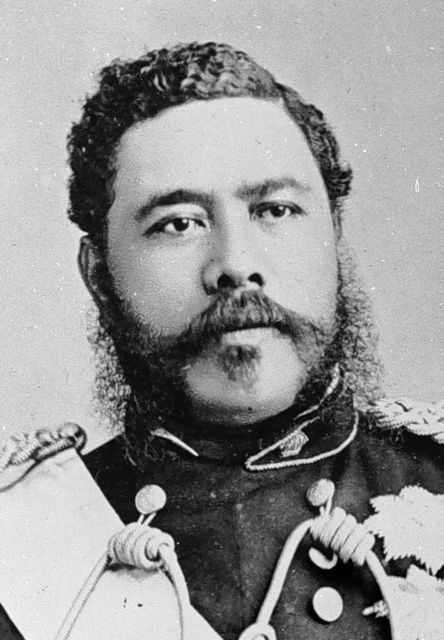 The Legislative Assembly convened again in special session on February 12, 1874 and elected King Kalakaua after Lunalilo, who died without children, failed to appoint a successor. Upon ascension to the Throne, King Kalakaua appointed his brother Prince William Pitt Leleiohoku as his heir apparent and received confirmation from the Nobles. Leleiohoku died April 10, 1877, which prompted
The Legislative Assembly convened again in special session on February 12, 1874 and elected King Kalakaua after Lunalilo, who died without children, failed to appoint a successor. Upon ascension to the Throne, King Kalakaua appointed his brother Prince William Pitt Leleiohoku as his heir apparent and received confirmation from the Nobles. Leleiohoku died April 10, 1877, which prompted 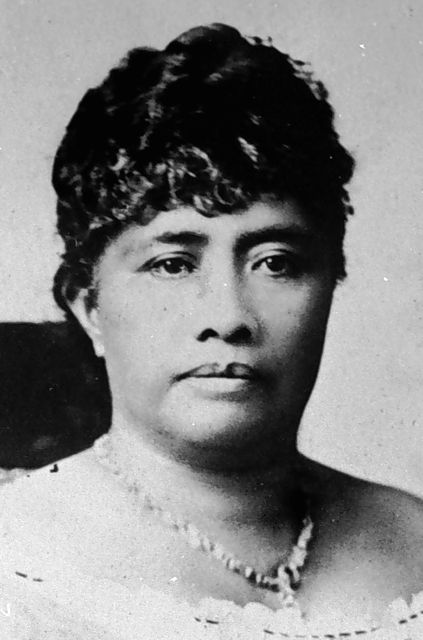 Kalakaua to immediately appoint his sister on the same day, Princess Lili‘uokalani, as his heir apparent and he received confirmation from the Nobles. An heir apparent is a person who is first in line of succession to the Throne according to Hawaiian law and cannot be displaced. An heir presumptive, however, is the person, male or female, entitled to succeed to the Throne, but can be replaced by an heir apparent pronounced according to Hawaiian law.
Kalakaua to immediately appoint his sister on the same day, Princess Lili‘uokalani, as his heir apparent and he received confirmation from the Nobles. An heir apparent is a person who is first in line of succession to the Throne according to Hawaiian law and cannot be displaced. An heir presumptive, however, is the person, male or female, entitled to succeed to the Throne, but can be replaced by an heir apparent pronounced according to Hawaiian law.
When the Legislative Assembly elected King Kalakaua in 1874, a new Stirps had effectively replaced the former Stirps, being the Kamehameha dynasty, with the Keawe-a-Heulu dynasty. Although Lunalilo was an elected King, he was of the Kamehameha dynasty, through Kamehameha’s father, Keoua. Stirps is a direct “line descending from a common ancestor,” and applies to monarchical dynasties. The Stirps for the Kamehameha Dynasty was a direct line from Kamehameha with Keopuolani, being the highest ranking of his wives. Lunalilo was not a direct descendant of Kamehameha, but a direct descendant of Kamehameha’s father, Keoua, whose son, Kalaimamahu, was Kamehameha’s half-brother.
Keawe-a-Heulu was one of the four counselor chiefs to Kamehameha I when the 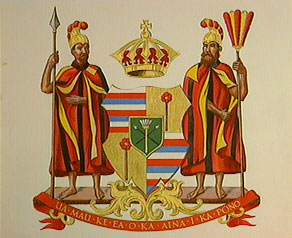 islands were consolidated under one kingdom. The other three counselor chiefs were Ke‘eaumoku, Kamanawa and Kame‘eiamoku. Ke‘eaumoku was the father of Ka‘ahumanu, one of Kamehameha’s wives and who later served as Prime Minister after Kamehameha’s death in 1819. Kamanawa and Kame‘eiamoku were brothers and are also represented in the Hawaiian Kingdom’s coat of arms.
islands were consolidated under one kingdom. The other three counselor chiefs were Ke‘eaumoku, Kamanawa and Kame‘eiamoku. Ke‘eaumoku was the father of Ka‘ahumanu, one of Kamehameha’s wives and who later served as Prime Minister after Kamehameha’s death in 1819. Kamanawa and Kame‘eiamoku were brothers and are also represented in the Hawaiian Kingdom’s coat of arms.
The Kamehameha dynasty also included the descendants of Kamehameha’s other wives, other than Keopuolani who was the mother of Kamehameha II and III, and the young Princess Nahienaena. These wives and children included: Peleuli who had Maheha Kapulikoliko, Kahoanoku Kina‘u, Kaiko‘olani and Kiliwehi; Kaheiheimalie who had Kamamalu and Kina‘u, who was the mother of Kamehameha IV and V, and Premier Victoria Kamamalu.
In 1883, the Keawe-a-Heulu Stirps was formally declared at the Coronation of King Kalakaua and Queen Kapi‘olani. Princess Lili‘uokalani as the heir apparent, and the heirs presumptive, being Princess Virginia Kapo‘oloku Po‘omaikelani, Princess Kinoiki, Princess Victoria Kawekiu Kai‘ulani Lunalilo Kalaninuiahilapalapa, Prince David Kawananakoa, Prince Edward Abnel Keli‘iahonui, and Prince Jonah Kuhio Kalaniana‘ole comprised the new royal lineage.
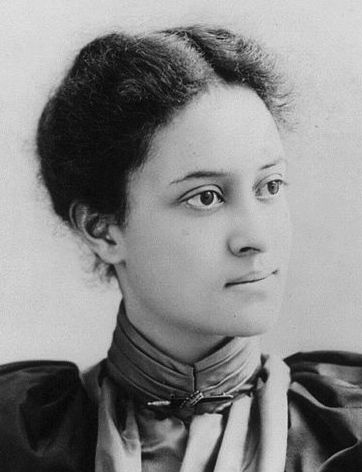 Queen Lili‘uokalani appointed Princess Ka‘iulani as her heir apparent in 1891, but was unable to get confirmation by the Nobles because they were prevented from entering the Legislative Assembly as a result of the so-called 1887 bayonet constitution that began the insurgency. In 1917, Queen Lili‘uokalani died with no such appointment or Proclamation leaving the Throne vacant. After the Queen’s death, only Prince Kuhio was left of the heirs presumptive. All the rest had died. Of the heirs presumptive, only Prince David Kawananakoa died with lineal descendants, but these lineal descendants did not inherit the title of heirs presumptive because they were not proclaimed as such by a reigning Monarch, as King Kalakaua did by proclamation in 1883. While these lineal descendants have no claim to the Throne, they are part of the Estate of the Ali‘i (Chiefs).
Queen Lili‘uokalani appointed Princess Ka‘iulani as her heir apparent in 1891, but was unable to get confirmation by the Nobles because they were prevented from entering the Legislative Assembly as a result of the so-called 1887 bayonet constitution that began the insurgency. In 1917, Queen Lili‘uokalani died with no such appointment or Proclamation leaving the Throne vacant. After the Queen’s death, only Prince Kuhio was left of the heirs presumptive. All the rest had died. Of the heirs presumptive, only Prince David Kawananakoa died with lineal descendants, but these lineal descendants did not inherit the title of heirs presumptive because they were not proclaimed as such by a reigning Monarch, as King Kalakaua did by proclamation in 1883. While these lineal descendants have no claim to the Throne, they are part of the Estate of the Ali‘i (Chiefs).
Crown Lands
Under the 1848 Great Mahele (Division), the King and Chiefs divided their interest between themselves and the Government. Under an Act Act relating to the lands of His Majesty the King and of the Government of June 7, 1848, the King separated his lands to be called Crown lands from the Government. In the Act it stated:
Know all men by these presents, that I, Kamehameha III, by the grace of God, King of the Hawaiian Islands, have given this day of my own free will and have made over and set apart forever to the chiefs and people the larger part of my royal land, for the use and benefit of the Hawaiian Government, therefore by this instrument I hereby retain (or reserve) for myself and for my heirs and successors forever, my lands inscribed at pages 178, 182, 184, 186, 190, 194, 200, 204, 206, 210, 212, 214, 216, 218, 220, 222, of this book, these lands are set apart for me and for my heirs and successors forever, as my own property exclusively.
The “book” Kamehameha was referencing the page numbers was the 1848 Buke Mahele also called the Mahele Book.
In 1863, the Hawaiian Kingdom Supreme Court decided a case titled In the Matter of the Estate of His Majesty Kamehameha IV, 2 Haw. 715 (1863). The case centered on dower rights of Queen Kalama wife of Kamehameha III and Queen Emma wife of Kamehameha IV. The case also clarified who are the successors to the nearly one million acres of Crown land. The Supreme Court stated:
By the said Act, which is entitled “An Act relating to the lands of his Majesty the King and of the Government,” the lands reserved to the then reigning sovereign, descend in fee, the inheritance being limited to the successors to the throne, each successive possessor having the right to dispose of the same as private property.
The heirs and successors to the Crown lands are successors to the throne and not the family. In 1864, Kamehameha V asked the Legislature to remove all encumbrances such as mortgage liens on the property that had greatly encumbered the Crown lands.
That year on January 3, the Legislature passed An Act to Relieve the Royal Domain from Encumbrances (January 3, 1865).This Act authorized the Minister of Finance to issue government bonds up to $30,000.00, and the money received through the bonds would pay off the debt lenders had on the Crown in order to release the mortgages. After the debts were cleared, the Act made Crown lands inalienable and limited the ownership of tenants to 30 year leases. By making the Crown lands inalienable they were no longer capable of being mortgaged.
The Act also established a Board of Commissioners of Crown Lands who collected the lease rent. The Commissioners of Crown Lands managed the purse of the Crown. There was no tax that the people paid for to maintain the office of the Crown.
Currently, there are pretenders to the Estate of the Crown. Some claims are well known, while others are not, but all claims to the Crown lands have no basis in Hawaiian law because Her late Majesty Queen Lili‘uokalani did not appoint and thereafter proclaim her successor in accordance with the law as it was done in the past. The office of the Crown can only be filled by an election by the Legislative Assembly as it was done in the case of King Lunalilo in 1873 and King Kalakaua in 1874.
The Estate of Nobles (Chiefs)
The political class of Ali‘i is an integral component of the Hawaiian Kingdom and its government and has its origin deeply rooted in Polynesian society. The entire land system of the Kingdom that continues to exist today is grounded and based on actions taken by the Ali‘i such as the granting of Royal Patents, Land Commission Awards, and the Great Land Division (Mahele) between the Government and Chiefs, which also set the terms of division between both the Government and Chiefs and native tenants desiring to get a fee-simple title to their lands.
In 1880, confusion as to who comprises the Hawaiian nobility got the Hawaiian Legislature to enact “An Act to Perpetuate the Genealogy of the Chiefs of Hawaii.” In the preamble of the act it stated, “at the present day it is difficult to ascertain who are the chiefs, as contemplated by said Article of the Constitution, and it is proper that such genealogies of the kingdom be perpetuated.”
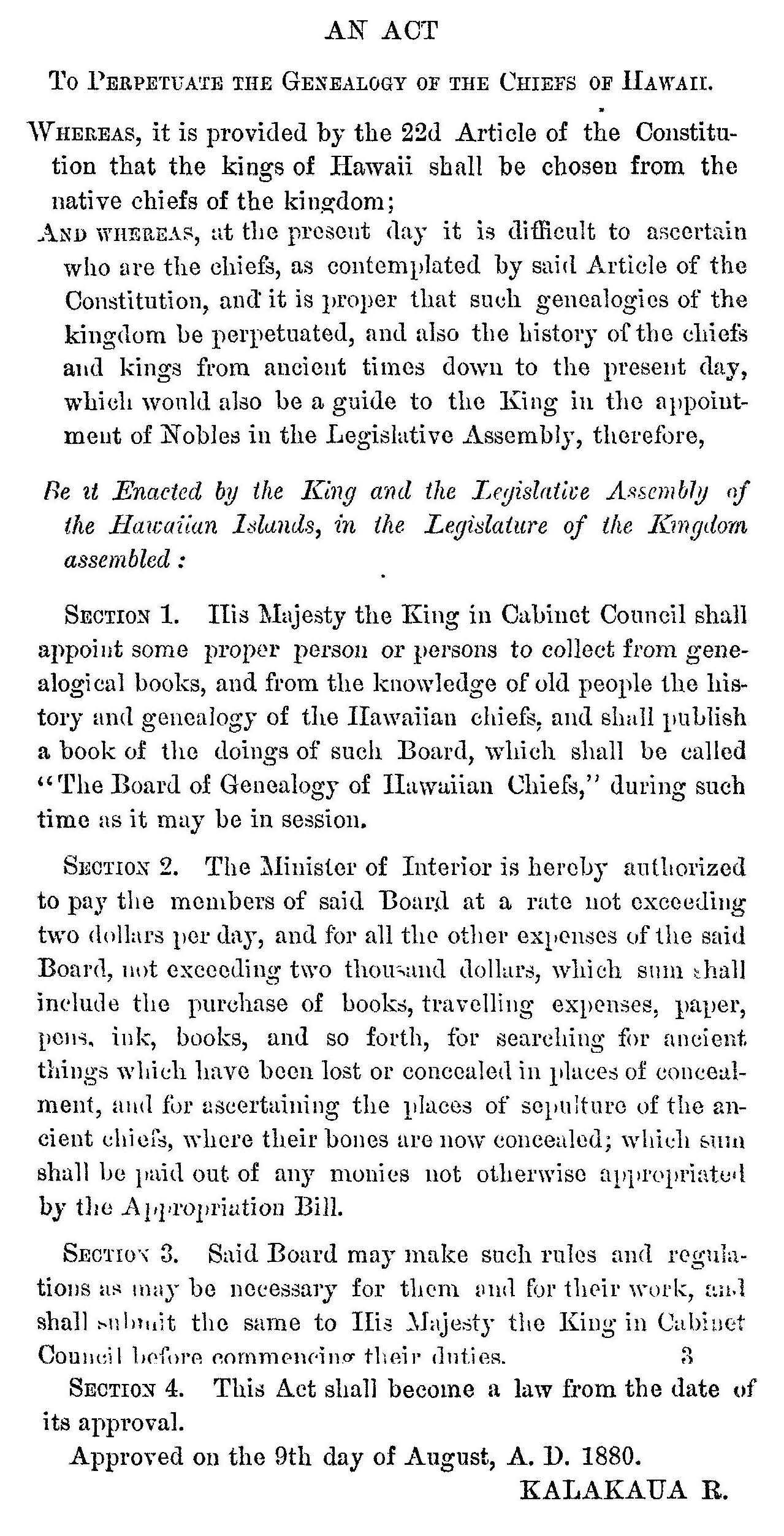 According to the Rules of the Board, their principle duties are: “1. To gather, revise, correct and record the Genealogy of Chiefs. 2. To gather, revise, correct and record all published and unpublished Ancient Hawaiian History. 3. To gather, revise, correct and record all published and unpublished Meles (Songs), and also to ascertain the object and the spirit of the Meles, the age and the History of the period when composed and to note the same on the Record Book. 4. To record all the tabu customs of the Mois (Kings) and Chiefs.”
According to the Rules of the Board, their principle duties are: “1. To gather, revise, correct and record the Genealogy of Chiefs. 2. To gather, revise, correct and record all published and unpublished Ancient Hawaiian History. 3. To gather, revise, correct and record all published and unpublished Meles (Songs), and also to ascertain the object and the spirit of the Meles, the age and the History of the period when composed and to note the same on the Record Book. 4. To record all the tabu customs of the Mois (Kings) and Chiefs.”
In its Report in 1884, the Board stated it was examining copies of genealogical books by Kamokuiki, Kaoo, Kaunahi, Unauna, Hakaleleponi, Piianaia, Kalaualu and David Malo, and that the “Board has not entered into revision of these books and those written by foreign historians as the time has been taken up mostly in attesting the genealogy of those that have applied to have their genealogy established.” The Board also reported, that it “has avoided entering into controversies with the genealogical discussions that have been going on for a year or more in the local Hawaiian newspapers, as these discussions have been more or less conducted in a partisan spirit instead of on scientific principles. They loose the merit of usefulness by the hostilities assumed by the contending writers.”
On July 5, 1887, the newly appointed Cabinet Council and two members of the Supreme Court committed the high crime of treason by coercing King Kalakaua to sign a new constitution under threat of assassination. This so-called constitution came to be known as the Bayonet Constitution and was never submitted to the Legislative Assembly for approval, which is required under law. Hawaiian constitutional law provides that any proposed change to the constitution must be submitted to the Legislative Assembly, and upon majority agreement, would be deferred to the next legislative session for action. Once the next legislature convened, and the proposed amendment or amendments were “agreed to by two-thirds of all members of the Legislative Assembly, and be approved by the King, such amendment or amendments shall become part of the Constitution of this country (Article 80, 1864 Constitution).”
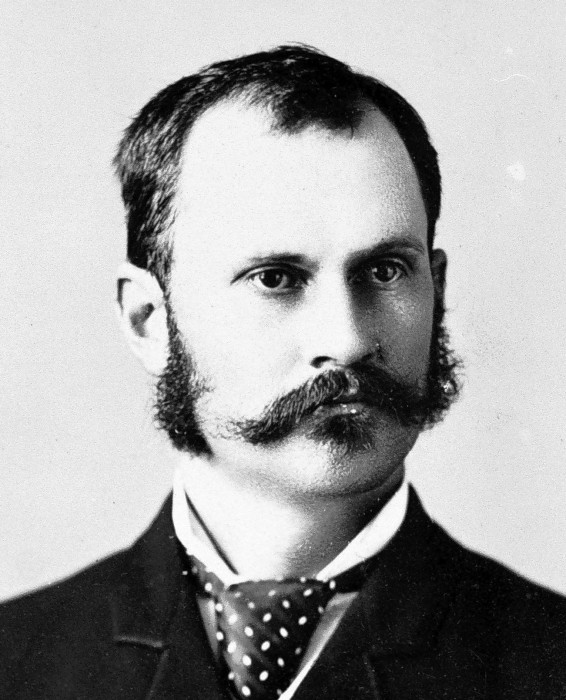 This so-called constitution was drafted by a select group of twenty individuals and effectively placed control of the Legislature and Cabinet in the hands of individuals who held foreign allegiances, which led to the illegal overthrow of the Hawaiian government by the United States of America. The leader of this insurgency, Lorrin Thruston, was the Minister of the Interior, and he refused to fund the Board of Genealogists
This so-called constitution was drafted by a select group of twenty individuals and effectively placed control of the Legislature and Cabinet in the hands of individuals who held foreign allegiances, which led to the illegal overthrow of the Hawaiian government by the United States of America. The leader of this insurgency, Lorrin Thruston, was the Minister of the Interior, and he refused to fund the Board of Genealogists 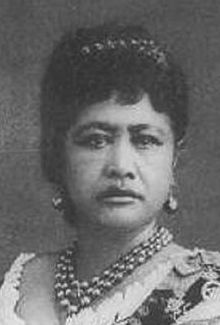 as required by law. In a letter to Her Royal Highness Princess Po‘omaikelani, President of the Genealogical Board, dated July 29, 1887, Thurston writes, “I beg to acknowledge receipt of your communication of the 27th inst. in which you state the labors of the board need not be suspended because the appropriation cannot be paid. There can, of course, be no objection to a continuation of the work of the Board of Genealogy so long as it is carried out without expense to the Government.”
as required by law. In a letter to Her Royal Highness Princess Po‘omaikelani, President of the Genealogical Board, dated July 29, 1887, Thurston writes, “I beg to acknowledge receipt of your communication of the 27th inst. in which you state the labors of the board need not be suspended because the appropriation cannot be paid. There can, of course, be no objection to a continuation of the work of the Board of Genealogy so long as it is carried out without expense to the Government.”
Despite the lack of government funding and the illegal overthrow of the Hawaiian Kingdom government, the Board continued their work to compile the genealogies of Hawaiian Chiefs (Mo‘okua‘auhau Ali‘i) that were eventually published in the Ka Maka‘ainana newspaper in the year 1896.
The acting Government is providing these publications, which are in the Hawaiian language, to the public at large with a link to the original publication in PDF by date of the publication. The names of Hawaiian Chiefs below are printed as they are written in the published genealogies, which did not have any diacritical markers such as the ‘okina or kahako. The English translations of these publications can be drawn from Edith Kawelohea McKinzie and Ishmael W. Stagner, II, Hawaiian Genealogies, vol. 1. A basic glossary of terms that can be used to understand the published genealogies are:
“k” is short for kane (male)
“w” is short for wahine (female)
noho (to live with, but used to mean the same as marriage)
mare (married)
a‘ohe pua (no lineal descendants)
kuamo‘o (lineage)
kuauhau (genealogy)
loa‘a (had)
mo‘o kuauhau (genealogical succession)
June 1, 1896—Genealogies of King Kamehameha IV and King Lunalilo, both of whom died without lineal descendants.
June 8, 1896—Genealogies of King Kalakaua and Queen Liliuokalani, both of whom died without lineal descendants.
June 15, 1896—Genealogy of Princess Kaiulani, who died without lineal descendants.
June 29, 1896—Genealogies of Queen Kapiolani, who died without lineal descendants; Prince Jonah Kuhio Kalanianaole who died without lineal descendants; and David Kawananakoa.
July 6, 1896—Genealogies of William Piikoi Wond, Lydia Kamakee Cummins, and Maraea Cummins; Daisy Napulahaokalani, Eva Kuwailanimamao, Roberto Kalaninuikupuaikalaninui Keoua and Virginia Kahoa Kaahumanu Kaihikapumahana.
July 13, 1896—Genealogy of Albert Kekukailimoku Kunuiakea who died without lineal descendants.
July 20, 1896—Genealogies of Princess Bernice Pauahi who dies without lineal descendants, Princess Ruth Keelikolani who died without lineal descendants, and John Kamehamehanui who died without lineal descendants.
July 27, 1896—Genealogies of Alexandrina Leihulu Kapena who died without lineal descendants, Edward Kamakau Lilikalani, and Annie Palekaluhi Kaikioewa who died without lineal descendants.
August 3, 1896—Genealogies of Sabina Kahinu Beckley, Frederick Kahapula Beckley, Jr., and Frederica Beckley; Leander Kaonowailani, Violet Kahaleluhi Kinoole, Grace Namahana i Kaleleokalani, Frederick Malulani, George Heaalii and Benjamin Kameeiamoku; William Kauluheimalama Beckley, Henry Hoolulu Beckley, Juanita Beckley, and George Mooheau Beckley, Jr.; Henry Hoolulu Pitman, Mary Kinoole (Mrs. Mary Ailau), and Benjamin Pitman, Jr.; Robert Hoapili Baker, Henry Kanuha, and Rev. J. Kauhane of Kau.
August 10, 1896—Genealogies of William Hoapili Kaauwai, Jr., Luka Kaauwai and Lydia Kahanu Kaauwai; Mary Parker (Mrs. Maguire), Eva Kalanikauleleiaiwi Kahiluonapuaonahonoapiilani Parker, Helen Umiokalani Parker, John Palmer Parker, Hattie Kaonohilani Parker, Palmer Kuihelani Parker, Samuel Keaoililani Parker, Ernest Napela Parker, and James Kekookalani Parker.
August 17, 1896—Genealogies of Lydia Kamakanoe Kanehoa, Albert Kaleinoanoa Kanehoa, Jno Kupakee Kanehoa, Davida K. Hoapili Kanehoa, and Maria Kalehuaikawekiu Kanehoa; Hoapiliwahine-a-Kanehoa; and the children of Makainai-a-Kuakini and Kauina, being Jesse Makainai, Keeaumoku, Kapaleiliahi, Kaumaumaeha, Hoapili Liilii, and Paulo Hoapili; Henry St. John Kaleookekoi Nahaolelua, George William Lua Nahaolelua, John Vivian St. John Kapokini Nahaolelua, Charles Kalaninoheainamoku Nahaolelua, Albert Kamainiualani Nahaolelua, Alexander Pahukula Kuanamoa Nahaolelua, Elizabeth Alice Kalakini Nahaolelua, and Emma Rhoda Kaaiohelo Nahaolelua; William Kapahukula Enelani Stevens who died without lineal descendants, and Keliikui Stevens who also died with lineal descendants.
August 24, 1896—Genealogies of Rose Kekupuohi Simerson, William Kuakini Simerson and Isaac Kaleialii Simerson; and the children of Annie Niulii and Kahaleaahu, being Helen Kalolowahilani, John Paalua and David Kauluhaimalama.
August 31, 1896—Genealogies of Annie Thelma Kahiluonapuaonahonoapiilani Parker; Kahaule-o-Kuakini and Mrs. Maluhi Reis; John Meek, Jr.; and Maraea Kaoaopa died without lineal descendants.
September 7, 1896—Genealogies of Adele Mikahala Unauna, John Koii Unauna, Maraea Kapumakokoulaokalani Unauna, Kaniu Unauna, Kahelemanolani Unauna, Jane Kulokuloku Unauna, Hattie Kaauamookalani Unauna and James Kalimaila Unauna; Julia Kailimahuna Koii, Lydia Kahuakai Koii, Lydia Kahuakai Koii, David Koii who died without lineal descendants, and Esther Namahana Koii; Julia Kapakuialii Kalaninuipoaimoku Doiron and Moses Koii Luhaukapewa Doiron; William Kahoapili Kekohimoku Alohikea, Alfred Unauna Alohikea, David Kauahiaalaiwilani Kaili; Alexander Boki Reis, Palmyra Lonokahikini Reis, and Helen Kekumualii Reis; and Helina Kaiwaokalani Maikai, David Unualoha Maikai, Samuela Kahilolaamea Maikai, and Abigaila Kalanikuikepo‘oloku Maikai.
October 5, 1896—Genealogies of Stella Keomailani Cockett who died without lineal descendants; and the child of Kekulu and Kaiakoili, being David Kalani.
October 19, 1896—Genealogies of Tilly Kaumakaokane Cummins, Thomas Keauiaole Cummins, and John T. Walker Cummins; King Keaweaua Mersberg, James Kahai Mersberg, Jr., Lily Kahalewai Mersberg, Marie Mersberg, Lydia Mersberg, Jane Piilani Mersberg, and Charles Mersberg; John Adams Kaenakulani Cummins, Thomas C. Kaihikapu Cummins, and Raplee Kawelokalani Cummins; May Kaaolani Cummins Creighton; Flora Kahanolani Cummins; children of Kekupuo-i; Ponilani Kaiama (w), Margaret Loe Kaiama, Esther Nahaukapuokalani Kaiama, Levi Kaiama and Keliimaikai Kaiama; Grace Kamaikui Piianaia, Niaupio Piianaia, and Heulumanawaokalani Piianaia (k); Phoebe Ulualoha Wilcox; and Daniel Kekuhio Keliiaa and Kekukamaikalani Keliiaa.
October 26, 1896—Genealogy of Katherine Kaonohiulaokalani Brown who died without lineal descendants.
November 2, 1896—Genealogy Hana Kaunahi and Akahi who both died without lineal descendants.
After the death of Prince Kuhio Kalaniana‘ole on January 13, 1922, the Associated Press reported, “Fourteen chiefs selected by the committee from the high chiefs of Hawaii will bear the casket of Prince Kuhio at the funeral Sunday morning. The selection are Henry P. Beckley, Edwin Kea, David Hoapili, Sr., Kaliinonao, John Nahaolelua, Alex Nahaolelua, Jesse Makainai, William Simerson, John H. Wise, William Taylor, Geo. Kalohapauole, David Maikai, Ahapuni Boyd, Clement Parker, Samuel Parker, Jr., as bearer of orders and David Hoapili, Jr. as bearer of the tabu stick.” These men were selected from the Estate of Ali‘i (Chiefs).
 Any person today who is a direct lineal descendant of the Hawaiian Chiefs identified in these published genealogies belong to the Estate of Nobles (Chiefs), and are eligible to be appointed as Nobles in the Legislative Assembly and/or to the Throne in accordance with Hawaiian law.
Any person today who is a direct lineal descendant of the Hawaiian Chiefs identified in these published genealogies belong to the Estate of Nobles (Chiefs), and are eligible to be appointed as Nobles in the Legislative Assembly and/or to the Throne in accordance with Hawaiian law.
The Estate of the People
Any person today who is a direct lineal descendant of a Hawaiian subject before the United States occupation began on January 17, 1893, belong to the Estate of the People.
Big Island Video News (BIVN): Ruggles Supporters Target Recent Councilmember Comments
(BIVN)– The Hawaiʻi County Council again heard testimony from “protected persons” in support of absent Puna councilmember Jen Ruggles on Wednesday.
Hawaiian Kingdom subjects and advocates, as they have in the past, told the council to “cease and desist from legislating” until the county’s Corporation Counsel can assure the governing body that they are not incurring criminal liability under U.S. and international law. Ruggles’ council seat has sat empty during meetings as she awaits an opinion from Corp Counsel.
On September 24, Ruggles held a community meeting in Keaʻau to explain her ongoing absence from council, and to show her constituents how she came to understand the Hawaiian Kingdom still exists as a state in continuity that is under a “strange form of occupation” by the United States.
During the Keaʻau meeting, and in a subsequent media release, Ruggles announced she was putting Queen’s Health Systems on notice, saying that changes to the hospital’s charter since 1909 “appear to violate article 47 and 50 of the Geneva Convention IV.” Ruggles said she called upon the Chief Executive Office of the Queen’s Health System, Mr. Art Ushijima, and the “Board of Trustees to comply with the 1859 Charter and to admit aboriginal Hawaiians, as that term was understood under Kingdom law, for medical care free of charge. Failure to do so [would] appear to constitute war crimes under Article 47 and 50 of the [Geneva Convention, IV].”
Ruggles said, “as an agent of the the United States as defined under the Hague Convention and whistleblower, it is my duty to hold individuals and other officials of the State of Hawai‘i and the United States government accountable for apparent violations of the Hague and Geneva Conventions and the rights of civilians within the occupied territory under the title of protected persons.”
Ruggles’ fellow Hawaiʻi County Councilmembers weighed-in on the situation in recent news articles. A “perplexed” Hilo councilman Aaron Chung told the Hawaiʻi Tribune-Herald he found it very confusing that Ruggle’s “would use her title in the County Council to advance a particular position.”
The West Hawaiʻi Today reported on October 2 that Council Chair Valerie Poindexter said she was “not going to fund the office if she’s not going to do any more legislative work,” and has refused Ruggles’ request to hire a council aide to fill the position recently vacated by one of Ruggles’ two staffers.
Testifiers took aim at Poindexter on Wednesday. Kale Gumapac told the chair to “please be aware that by impeding Councilwoman Ruggles in anyway only provides more evidence for ‘War Crime’ charges against you with no statute of limitation.”
#ProtectedPersonsHawaii
#WarCrimesHawaii
NEA Teachers Union Published Article on the American Occupation of Hawai‘i
This past April, the National Education Association (NEA), being the largest labor union in the United States comprised of public school teachers, administrators, and faculty and administrators of universities, published an article on its website titled “The Illegal Overthrow of the Hawaiian Kingdom Government.”
The article is a departure from the common belief that Hawai‘i is the 50th State of the American Union. Instead, Hawai‘i is an independent State that has been under an illegal and prolonged occupation by the United States since January 17, 1893.
The NEA acknowledged that “on December 18, 1893, the President proclaimed by manifesto, in a message to the United States Congress, the circumstances for committing acts of war against the Hawaiian Kingdom that transformed a state of peace to a state of war on January 16, 1893.” Without a treaty of peace, the Hawaiian Kingdom and the United States remain in a state of war and the Hawaiian Islands have been under a prolonged occupation. The NEA concluded in its article:
Despite the unprecedented prolonged nature of the illegal occupation of the Hawaiian Kingdom by the United States, the Hawaiian State, as a subject of international law, is afforded all the protection that international law provides. “Belligerent occupation,” concludes Judge Crawford in his book The Creation of States in International Law (2nd ed., 2006), “does not affect the continuity of the State, even where there exists no government claiming to represent the occupied State (p. 34).” Without a treaty of peace, the laws of war and neutrality would continue to apply.
The significance of this article is that the NEA has taken a position based on historical facts and not political leanings. The article will be referenced by teachers across the United States that explains to their students the lawful status of the Hawaiian Kingdom under international law.
The NEA’s article stems from a resolution that was passed by its delegates who met at their annual convention in 2017 in Boston, Massachusetts.
The resolution was introduced by the delegates of the Hawai‘i State Teachers Association, which is an affiliate labor union of the NEA, and it passed on July 4, 2017. The resolution was referred to as New Business Item 137, which stated:
The NEA will publish an article that documents the illegal overthrow of the Hawaiian Monarchy in 1893, the prolonged occupation of the United States in the Hawaiian Kingdom and the harmful effects that this occupation has had on the Hawaiian people and resources of the land.
#ProtectedPersonsHawaii
#WarCrimesHawaii
Council Member Jenn Ruggles Puts Queen’s Hospital on Notice for Committing War Crimes Against Native Hawaiians
 Council member Jen Ruggles released a letter she sent last week notifying Queen’s Health Systems of the illegal and prolonged occupation of Hawai’i and how it appears it may be violating the rights of protected persons in Hawai’i. She stated that she, as an agent for the United States, which is an occupying Power, and one who took an oath to support the constitution of the United States, is bound to uphold the 1907 Hague Convention, IV, and the 1949 Geneva Convention, IV, and ensure respect for the conventions in all circumstances.
Council member Jen Ruggles released a letter she sent last week notifying Queen’s Health Systems of the illegal and prolonged occupation of Hawai’i and how it appears it may be violating the rights of protected persons in Hawai’i. She stated that she, as an agent for the United States, which is an occupying Power, and one who took an oath to support the constitution of the United States, is bound to uphold the 1907 Hague Convention, IV, and the 1949 Geneva Convention, IV, and ensure respect for the conventions in all circumstances.
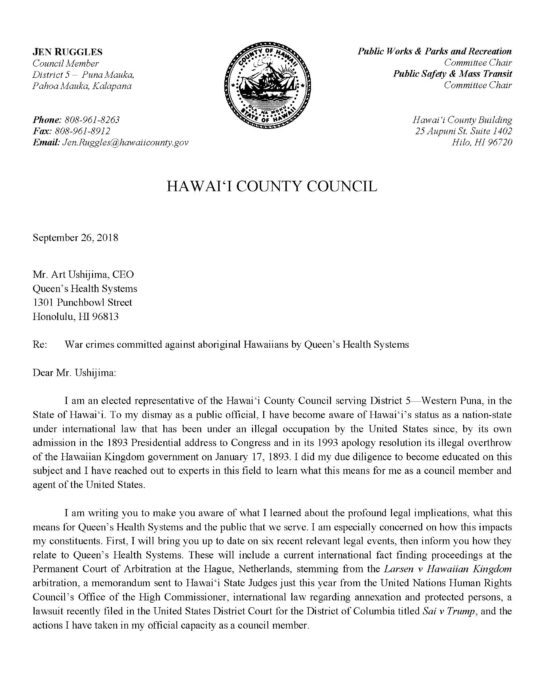 In her letter Council member Ruggles referenced a February 25, 2018 communication from United Nations Independent Expert, Dr. Alfred M. deZayas, to the State of Hawai‘i judges in which he stated:
In her letter Council member Ruggles referenced a February 25, 2018 communication from United Nations Independent Expert, Dr. Alfred M. deZayas, to the State of Hawai‘i judges in which he stated:
“I have come to understand that the lawful political status of the Hawaiian Islands is that of a sovereign nation-state in continuity; but a nation-state that is under a strange form of occupation by the United States resulting from an illegal military occupation and a fraudulent annexation. As such, international laws (the Hague and Geneva Conventions) require that governance and legal matters within the occupied territory of the Hawaiian Islands must be administered by the application of the laws of the occupied state (in this case, the Hawaiian Kingdom), not the domestic laws of the occupier (the United States).”
The U.S. Senate ratified the Hague and Geneva Conventions making both of these treaties part of federal law under Article VI of the federal constitution and which must be faithfully carried out in territory that the United States is occupying. As a whistle blower, Council member Ruggles sees it as her duty to hold individuals and other officials of the State of Hawai‘i and the United States government accountable for violations of the provisions of the Hague and Geneva Conventions and the rights of civilians within the occupied territory under the title of protected persons.
Council member Ruggles came to learn that the Queen’s Hospital was formed as a corporation on June 20, 1859. Article One of the Hospital’s Charter provides for the establishment of a permanent hospital for the “treatment of indigent sick and disabled Hawaiians, as well as such foreigners and others who may choose to avail themselves of the same.” It was understood, at the time, that the term ‘Hawaiians’ meant aboriginal Hawaiians, both pure and part. Under the Charter, the Hawaiian Monarch served as President of a Board of Trustees comprised of ten persons to be appointed by the government and ten persons to be elected by corporation shareholders.
The government appropriated funding for the maintenance of the hospital.
In 1900, George W. Smith, a Trustee of Queen’s Hospital, stated in an article published by the Pacific Commercial Advertiser that “Queen’s Hospital is, from the nature of its charter, a quasi-private institution. When it was chartered it was provided that all Hawaiians of native birth, should be treated free of charge. Foreigners were to be treated by payment of fees.”
No other country or government in the world at the time is known by her to have had such a system of government subsidized health care for a majority of its national population which was free of charge. The Soviet government followed this practice in 1920, but that was due to the political theory of communism. After the Second World War, in 1948, the British government followed suit, which, like the Hawaiian Kingdom, was not a communist State. The Nordic countries followed with Sweden in 1955, Iceland in 1956, Norway in 1956, Denmark in 1961, and Finland in 1964. The United States has never subsidized health care free of charge.
After pressure to sever the Hawaiian government’s interest in Queen’s Hospital and to no longer admit native Hawaiians free of charge, the Board of Trustees, with the approval of Territorial Governor, Walter F. Frear, amended the Charter. In 1909, the phrase in the original 1859 Charter “for the treatment of indigent sick and disabled Hawaiians” was replaced with “for the treatment of sick and disabled persons.” The change was made secretively. The only news coverage it received at the time was in one newspaper, the Evening Bulletin, which made no mention of the change of servicing aboriginal Hawaiians free of charge. Under the title of “IS APPROVED TRUSTEES REDUCED,” the Bulletin wrote,
“By the new amendment to their character, the application for which was approved by Governor Frear this morning, the number of trustees of Queen’s Hospital will be reduced from twenty to seven members. The responsibility of the government trusteeship will also cease with the new articles of incorporation.”
By 1939, Victor Stewart Kaleoaloha Houston, a former Congressional delegate for the Territory of Hawai‘i, “was presenting lectures at various Hawaiian Civic Clubs castigating Queen’s Hospital for ignoring Native Hawaiians’ medical needs and reneging on the promises of the original charter. In newspapers the main themes of Houston’s one man challenge to Queen’s practices was set out for the public by these questions: What ever happened to free medical care for Hawaiians and what is Queen’s doing with the Queen Emma Trust monies?”
Gradually aboriginal Hawaiians were denied health care unless they paid, and as time went on, this provision of the Queen’s Hospital charter was nearly forgotten. In 1967, the name of Queen’s Hospital was changed to the Queen’s Medical Center. In 1985, the Queen’s Health Systems with a Board of Trustees was established as the parent company of Queen’s Medical Center along with Molokai General Hospital, North Hawai‘i Community Hospital, Queen Emma Land Company, Queen’s Development Corporation, and Queen’s Insurance Exchange. Under Queen’s Health Systems there are four hospitals—The Queen’s Medical Center, The Queen’s Medical Center – West O‘ahu, Molokai General Hospital, and North Hawai‘i Community Hospital—and seven health care centers in Hawai‘i Kai, Hilo, two in Honolulu, Kapolei, Kaua‘i and Kona. I will refer to the corporation by its original name, the Queen’s Hospital.
Hawaiian subjects of aboriginal blood, both pure and part, are protected persons whose rights during the U.S. occupation are protected under the Geneva Convention. Council member Ruggles sees that it is also her duty as a whistle blower and agent for the United States to ensure that their rights are respected and enforced. According to the Office of Hawaiian Affairs, “Today, Native Hawaiians are perhaps the single racial group with the highest health risk in the State of Hawai‘i. This risk stems from high economic and cultural stress, lifestyle and risk behaviors, and late or lack of access to health care.” The ‘lack of access to health care’ is what troubles Council member Ruggles knowing that the Queen’s Hospital was specifically established, under Hawaiian Kingdom law, to provide for their health care, free of charge.
According to the International Committee of the Red Cross Commentaries, Article 47 of the Geneva Convention means that “changes made in the internal organization of the State must not lead to protected persons being deprived of the rights and safeguards provided them. Consequently it must be possible for the Convention to be applied to them in its entirety, even if the Occupying Power has introduced changes in the institutions or government of the occupied territory.” Furthermore, under the provisions of Article 50 of the GCIV regarding preferential measures for children’s medical care, in this case with the Queen’s Hospital, the occupying State “who occupied the whole or part of a territory where such measures are in force, cannot on any pretext abrogate them or place obstacles in the way of their application. This rule applies not only to preferential measures prescribed in the Convention but to any other measures of the same nature taken by the occupied State.”
Council member Ruggles stated that the changes to the charter since 1909 violate the Hague and Geneva Conventions. In light of these violations, she called upon the Chief Executive Office of the Queen’s Health System, Mr. Art Ushijima, and the “Board of Trustees to comply with the 1859 Charter and to admit aboriginal Hawaiians, as that term was understood under Kingdom law, for medical care free of charge. Failure to do so [would] appear to constitute to constitute war crimes under Article 47 and 50 of the [Geneva Convention, IV].”
Council member Ruggles alerted Mr. Ushijima to the fact that there “seems to be a direct nexus of deaths of aboriginal Hawaiians as ‘the single racial group with the highest health risk in the State of Hawai‘i [that] stems from…late or lack of access to health care’ to the crime of genocide as defined by the 1948 Convention on the Prevention and Punishment of the Crime of Genocide. The Genocide Convention was also ratified by the United States Senate, and, like the Hague and Geneva Conventions, are a part of United States federal law.
#ProtectedPersonsHawaii
#WarCrimesHawaii
Big Island Video News (BIVN): Jen Ruggles Holds Community Meeting On War Crimes
(BIVN)– A community meeting organized by Puna councilwoman Jen Ruggles to explain her ongoing absence from council drew a standing room-only crowd to the Keaʻau Community Center on Monday night.
Ruggles declared on August 21 “that she had come to understand that she may be in violation of her oath of office to uphold the U.S. Constitution and may be incurring criminal liability under both U.S. federal law and international law,” a media release stated. “Through her attorney, Stephen Laudig, she formally requested the County Office of Corporation Counsel provide her a proper legal opinion.”
Laudig was present at the meeting, as was Dr. David Keanu Sai, a scholar and expert in international law. Sai has also served as the lead agent for the Hawaiian Kingdom in international arbitration proceedings before the Permanent Court of Arbitration at the Hague, Netherlands.
Using a power point presentation projected onto the community center wall, Ruggles walked constituents through her understanding of the Hawaiian Kingdom as a state in continuity that is under a “strange form of occupation” by the United States. Ruggles shared letters she received that prompted her to make her decision, and took questions from the audience.
In an earlier media release, Ruggles said she intended “to educate her constituents on their rights as protected persons under U.S. and international law, and share what work she has started to continue to represent and advocate on behalf of her district.”
#ProtectedPersonsHawaii
#WarCrimesHawaii
Queen’s Hospital First Hawaiian Health Institution to Fall Victim to the Unlawful Occupation
The article below was printed on page 14 of The Pacific Commercial Advertiser on July 31, 1901 in Honolulu. It is a window into a time of colliding legal systems and the Queen’s Hospital would soon become the first Hawaiian health institution to fall victim to the unlawful imposition of American laws. Queen’s Hospital was established as the national hospital for the Hawaiian Kingdom and that health care services for Hawaiian subjects of aboriginal blood was at no charge. The Hawaiian head of state would serve as the ex officio President of the Board together with twenty trustees, ten of whom were from the Hawaiian government.
Since the hospital’s establishment in 1859 the legislature of the Hawaiian Kingdom subsidized the hospital along with monies from the Queen Emma Trust. With the unlawful imposition of the 1900 Organic Act that formed the Territory of Hawai‘i, American law did not allow public monies to be used for the benefit of a particular race. 1909 was the last year Queen’s Hospital received public funding and it was also the same year that the charter was unlawfully amended to replace the Hawaiian head of state with an elected president from the private sector and reduced the number of trustees from twenty to seven, which did not include government officers.
These changes to a Hawaiian quasi-public institution is a direct violation of the laws of occupation, whereby the United States was and continues to be obligated to administer the laws of the occupied State—the Hawaiian Kingdom. This requirement comes under Article 43 of the 1907 Hague Convention, IV, and Article 64 of the 1949 Geneva Convention, IV.
Article 55 of the Hague Convention provides, “The occupying State shall be regarded only as administrator and usufructuary of public buildings, real estate, forests, and agricultural estates belonging to the [occupied] State, and situated in the occupied country. It must safeguard the capital of these properties, and administer them in accordance with the rules of usufruct.” The term “usufruct” is to administer the property or institution of another without impairing or damaging it.
Despite these unlawful changes, aboriginal Hawaiian subjects, whether pure or part, are to receive health care at Queen’s Hospital free of charge. This did not change, but through denationalization there was an attempt to erase. Aboriginal Hawaiian subjects are protected persons as defined under international law, and as such, the prevention of health care by Queen’s Hospital constitutes war crimes.
***********
Queen’s Hospital Appropriation Peculiar.
PROVISION AS TO TREATMENT
Collision Between the Charter and the Bill Making the Grant for Period.
The Board of Health has a very delicate question to consider at its meeting this afternoon—one which places the Queen’s Hospital in a very queer situation.
The Legislature at its last session made an appropriation for the Queen’s Hospital of $40,000, to be used in the next biennial period. This was in line with the previous policy of the Government in making appropriation for the hospital, similar appropriations being made at the same time to other like institutions. There was, however, one very peculiar incident in connection with the appropriation made for the Queen’s Hospital. In the past the sum of $20,000 had always been given to the hospital for the biennial period, and Governor Dole recommended that the Legislature make the usual appropriation. Instead that body appropriated just double the amount asked, or $40,000.
Attached to the bill, however, was a rider providing that no distinction should be made as to race in the care of patients at the hospital. The appropriation was also placed in the hands of the Board of Health for proper payment and the Board now finds itself in a rather peculiar predicament.
The Queen’s Hospital was founded in 1859 by their Majesties Kamehameha IV and his consort Emma Kaleleonalani. The hospital is organized as a corporation and by the terms of its charter the board of trustees is composed ten members elected by the society and ten members nominated by the Government, of which the President of the Republic (now Governor of the Territory) shall be the presiding officer. The charter also provides for the “establishing and putting in operation a permanent hospital in Honolulu, with a dispensary and all necessary furniture and appurtenances for the reception, accommodation and treatment of indigent sick and disabled Hawaiians, as well as such foreigners and other who may choose to avail themselves of the same.”
Under this construction all native Hawaiians have been cared for without charge, while for others a charge has been made of from $1 to $3 per day. The bill making the appropriation for the hospital by the Government provides that no distinction shall be made as to race; and the Queen’s Hospital trustees are evidently up against a serious proposition.
Under the provisions of the Organic Act the Legislature has no power to give a subsidy to any institution and, under the construction likely to be placed by the Board of Health of the intentions of the Legislature, the Queen’s Hospital must be placed under the control of the Government before it may receive the appropriation of $40,000.
“I can see no way out of the difficulty at present,” said Secretary [George W.] Smith of the board of trustees for the Queen’s Hospital when his attention was called to the matter yesterday afternoon. “The hospital has been receiving regular stipulated amounts from the Government, generally $20,000 for each biennial period. This year when the Governor asked for a statement of the condition of the hospital’s finances it was handed to him, and he recommended that the Legislature make the usual allowance. I do not know they gave us $40,000 instead of the usual amount. There was a rider placed on the bill, however, to the effect that no distinction should be made as to race. The appropriation was also placed in the hands of the Board of Health. Formerly it was the custom for this money to be placed into the hands of the Minister of Finance and by him paid over quarterly directly to our treasurer. Why the change was made at this time I do not understand.”
“I do not see myself how the hospital could be placed in the hands of the Government, even if we wished to do so. The Government now has ten members upon the Board and also the presiding officer. Under our charter we are compelled to treat native Hawaiians free of charge, and I do not see how it can be changed. Then again we have in our hands $36,000 in trust funds which cannot very well be given over to the Government except in violation of the terms of the trust. Taken all around it is a very delicate question, and it is to be hoped that it may be settled without the loss of appropriation to the hospital. The hospital now treats free all soldiers and sailors and also the members of the police force.”
The matter will be discussed at this afternoon’s meeting of the Board of Health, though it is hardly likely that the matter can be definitely settled at this time. A joint meeting of the Board of Health and the trustees of the Queen’s Hospital will probably be held, at which the matter will be talked over before final action is taken.
***********
#ProtectedPersonsHawaii
#WarCrimesHawaii
Big Island Video News (BIVN): Hawaiian Kingdom Supporters Tell Council “Cease & Desist”
(BIVN)– In lengthy public testimony before the Hawaii County Council meeting got underway in Hilo on Wednesday, Hawaiian Kingdom supporters spoke out in support of absent councilwoman Jen Ruggles, and demanded the council “cease and desist” legislative activity.
Ruggles’ seat was empty as the councilmember from Puna announced she would “refrain from legislating” until the county’s corporation counsel can provide a “proper legal opinion” that will assure her that she “is not incurring criminal liability under international humanitarian law and U.S. law.”
Ruggles’ recent decision was not on the Wednesday’s council agenda for discussion, so testifiers seeking to support Ruggles’ position spoke on other matters, such as Bill 160 – a measure that amends the County Code of Ethics by requiring that officials “provide accurate and factual information to the public” to the best of their knowledge.
Public testifiers – both Hawaiian Kingdom subjects as well as American citizens – identified themselves as protected persons as defined under Article 4 of the 1949 Fourth Geneva Convention. Many read from similarly worded written testimony.
“I too have come to learn that the Hawaiian Kingdom continues to exist as an independent and sovereign State that has been under an illegal and prolonged occupation by the United States since January 17, 1893,” stated Kale Gumapac, who testified in Hilo. “I am also aware that the United Nations Independent Expert Dr. Alfred deZayas sent a memorandum to members of the State of Hawai‘i judiciary which stated ‘international laws (the Hague and Geneva Conventions) require that governance and legal matters within the occupied territory of the Hawaiian Islands must be administered by the application of the laws of the occupied state (in this case, the Hawaiian Kingdom), not the domestic laws of the occupier (the United States).’ And according to Amnesty International, war crimes are crimes that violate the laws or customs of war defined by the Hague and Geneva Conventions.”
“Article 43 of the Hague Regulations and Article 64 of the Fourth Geneva Convention obligates the United States to administer Hawaiian Kingdom law, not United States law,” Gumapac continued. “This deliberate in failure by the United States to administer Hawaiian kingdom law has led to grave breaches under Article 147 of the Fourth Geneva Convention and international humanitarian law. which constitutes war crimes committed against me as a protected person.”
Gumapac finished with a statement that was often repeated by others speakers on Wednesday. “This body illegally enacts United States laws in violation of the Hague and Geneva Conventions and as a victim of war crimes that stem from this unlawful legislation, I demand that this body immediately cease and desist,” Gumapac said.
Multiple testifiers spoke for roughly two hours before the Hawaii County Council closed public comment and went ahead with the scheduled agenda.
#ProtectedPersonsHawaii
#WarCrimesHawaii
UPDATE Emergency Petition for Writ of Mandamus – U.S. Attorney Will Seek 30 day Extension
On August 29, 2018, Assistant United States Attorney for the District of Columbia Rhonda L. Campbell sent a communication to Dr. David Keanu Sai, Chairman of the Council of Regency and Petitioner for an extension to respond to the Emergency Petition for Writ of Mandamus filed with the United States District Court for the District of Columbia.
“Sir: I will be requesting a 30-day extension of time, to and through, October 10, 2018, to Answer or otherwise respond to your complaint. Please inform me of your position. Thank you.”
Dr. Sai responded later that day:
“Ma’am: Notwithstanding the emergency nature of the petition for writ of mandamus, I am agreeable to your request.”



